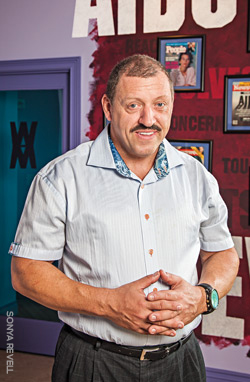 As director of operations at the World AIDS Museum and Educational Center in Wilton Manors, Florida, Ed Sparan gives one-hour docent tours of the facilities. He guides visitors through the main exhibit, which is a timeline of the virus—“People are surprised a panel goes back to 1908,” he notes—but the pièce de résistance is a sculpture titled “10 Year Ribbon,” in which an artist saved his Epzicom and Viramune bottles for a decade and transformed them into a red ribbon representing about $333,000 in HIV meds.
As director of operations at the World AIDS Museum and Educational Center in Wilton Manors, Florida, Ed Sparan gives one-hour docent tours of the facilities. He guides visitors through the main exhibit, which is a timeline of the virus—“People are surprised a panel goes back to 1908,” he notes—but the pièce de résistance is a sculpture titled “10 Year Ribbon,” in which an artist saved his Epzicom and Viramune bottles for a decade and transformed them into a red ribbon representing about $333,000 in HIV meds.
“People are in awe when I tell them that,” Sparan says. “They realize having HIV is not as simple as taking a single pill.” The sculpture spurs lots of questions, and Sparan can nimbly answer most of them. Which is no surprise—after all, he created the piece.
Art is a “great tool” for teaching about the epidemic, he says. In fact, the museum is hosting an AIDS awareness art project with 40 high schools across Broward County, which is home to both Fort Lauderdale and the museum. Winners from each school will be displayed in a gallery at the museum.
HIV education is needed in Florida. The state ranks second in the nation (behind California) for the highest number of new HIV cases, with Broward and Miami-Dade counties being the hardest hit.
The idea for the World AIDS Museum, which opened last year, originated in a local support group called POZitive Attitudes, facilitated by Steve Stagon. Already, the museum includes a media center, a video archive of personal HIV stories, plus displays about stigma and AIDS in the media—“The first issue of POZ is beautifully framed,” notes Sparan, formerly an actor in New York City. Visitors can also peruse a digital archive of the AIDS Memorial Quilt. “People tell me, ‘I made a quilt for so-and-so,’ then I type in the name and it comes up. They haven’t seen it in 20 years, and suddenly they’re crying in my arms,” Sparan says, then jokingly adds: “We need grant money for Kleenex!”
The museum’s varied collection is already growing fast. As Sparan explains, “A lady sent me an email saying, ‘Mike passed away in 1985. Mom took care of Mike. Can we send you mom’s diary of taking care of Mike?’ So we’ll have this kind of artifact too.”
Sparan and the museum team are already brainstorming future exhibits, movie nights, guest speakers and special events tailored to various populations—Latinos, African Americans, straight people, the transgender community. “The subject of AIDS is so complicated, and there are so many sides to it,” he acknowledges. “But we want everyone to come here and explore.”


Ed Sparan Sonya Revell






Comments
Comments